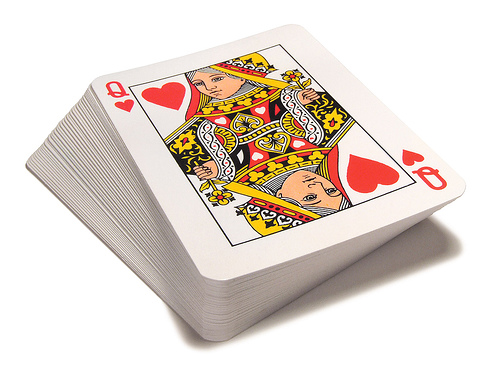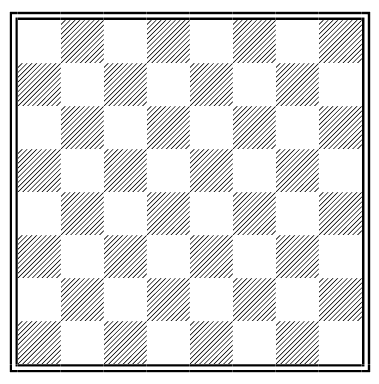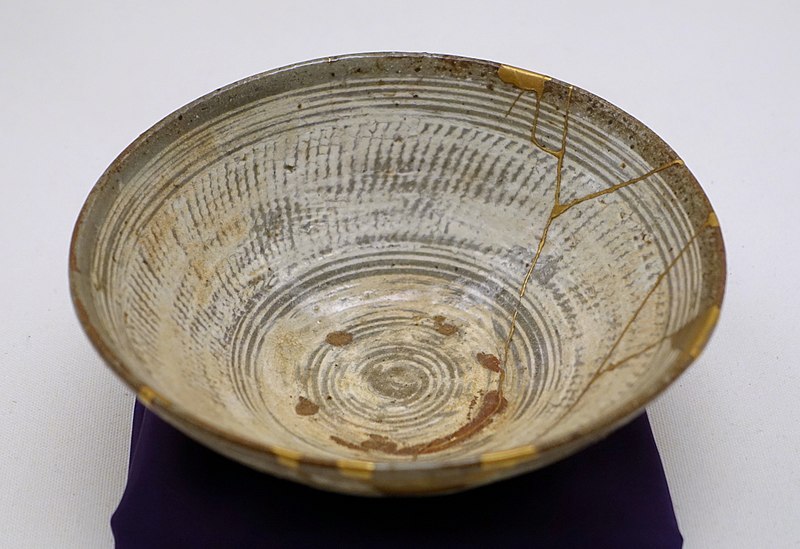This 2020 installation, by French artist Pierre Brault, is a reaction against accelerating lifestyles.
Fittingly, it takes a day to unfold.
This 2020 installation, by French artist Pierre Brault, is a reaction against accelerating lifestyles.
Fittingly, it takes a day to unfold.

A puzzle by Ben H., a systems engineer at the National Security Agency, from the agency’s August 2016 Puzzle Periodical:
At a work picnic, Todd announces a challenge to his coworkers. Bruce and Ava are selected to play first. Todd places $100 on a table and explains the game. Bruce and Ava will each draw a random card from a standard 52-card deck. Each will hold that card to his/her forehead for the other person to see, but neither can see his/her own card. The players may not communicate in any way. Bruce and Ava will each write down a guess for the color of his/her own card, i.e. red or black. If either one of them guesses correctly, they both win $50. If they are both incorrect, they lose. He gives Bruce and Ava five minutes to devise a strategy beforehand by which they can guarantee that they each walk away with the $50.
Bruce and Ava complete their game and Todd announces the second level of the game. He places $200 on the table. He tells four of his coworkers — Emily, Charles, Doug and Fran — that they will play the same game, except this time guessing the suit of their own card, i.e. clubs, hearts, diamonds or spades. Again, Todd has the four players draw cards and place them on their foreheads so that each player can see the other three players’ cards, but not his/her own. Each player writes down a guess for the suit of his/her own card. If at least one of them guesses correctly, they each win $50. There is no communication while the game is in progress, but they have five minutes to devise a strategy beforehand by which they can be guaranteed to walk away with $50 each.
For each level of play — 2 players or 4 players — how can the players ensure that someone in the group always guesses correctly?
During a visit to the Auschwitz-Birkenau Museum in 2016, University of Michigan music theory professor Patricia Hall discovered handwritten manuscripts of popular songs of the day. This one, “The Most Beautiful Time of Life,” is a light foxtrot based on a song by Franz Grothe, a popular German film composer. The prisoners had arranged it for the available instruments and musicians and probably performed it before the commandant’s villa in Sunday concerts for the Auschwitz garrison in 1942 or 1943.
“This was for the SS personnel,” she explained. “It was about a three-hour concert that was broken up into stages, and at one point, they had a dance band so that soldiers could dance. Given the instrumentation of this foxtrot, I think that’s probably what it was used for.”
Two of the arrangers had signed their prison numbers to the manuscript, so Hall was able to identify them: Antoni Gargul, a Polish soldier and a violinist, and Maksymilian Piłat, a professional bassoonist. Both of them survived the war, and Hall believes the unidentified third author may have as well.

Given a standard chessboard, you can choose any rank or file and repaint each of its squares to the opposite color (white squares turn black, and black squares turn white). By doing this repeatedly, is it possible to produce a board with 63 white squares and one black square?
“The most dangerous food is wedding cake.” — James Thurber

In the Japanese art of kintsugi, broken pottery is not discarded but mended with a lacquer mixed with gold, silver, or platinum, to connote an appreciation of the flawed and the imperfect and to mark the repair as one event in the object’s life, not the end of its useful service.
The Japanese philosophy of mushin finds an analogy with human life. Christy Bartlett writes in Flickwerk: The Aesthetics of Mended Japanese Ceramics (2008):
Not only is there no attempt to hide the damage, but the repair is literally illuminated … a kind of physical expression of the spirit of mushin. … Mushin is often literally translated as ‘no mind,’ but carries connotations of fully existing within the moment, of non-attachment, of equanimity amid changing conditions. … The vicissitudes of existence over time, to which all humans are susceptible, could not be clearer than in the breaks, the knocks, and the shattering to which ceramic ware too is subject.
“This poignancy or aesthetic of existence has been known in Japan as mono no aware, a compassionate sensitivity, or perhaps identification with, [things] outside oneself.”
(See Edifice Complex.)
Today through Thursday, get 20% off everything in the Futility Closet store — shirts, mugs, phone cases, and more. Thanks for your support!

In 2009, in the little Swiss town of Teufen, conceptual artists Frank and Patrik Riklin converted a 1980s-era nuclear fallout shelter to the “Null Stern Hotel,” an underground facility that accommodates 14 guests in a concrete bunker fitted with blast doors nearly two feet thick.
“We kept the internal structure of the shelter intact — the concrete and the ductwork — and then we added the warmth of antique beds and furniture,” Patrik told the Guardian. “For us it’s an art installation before it’s a hotel — a place where people can think about their surroundings.” There are no windows, only a CCTV camera displaying the outside world, and they retained the institutional paint scheme of pastel blue and yellow.
The site was nominated for best innovation of the year in the 2009 Worldwide Hospitality Awards, and GEO magazine ranked it among the Top 100 hotels in Europe the following year. In 2010 the proprietors were seeking to expand the franchise, but to date no hotel has opened beyond Teufen.

In 1864, two ships’ crews were cast away at the same time on the same remote island in the Southern Ocean. But the two groups would undergo strikingly different experiences. In this week’s episode of the Futility Closet podcast we’ll tell the story of the Auckland Islands castaways and reflect on its implications for the wider world.
We’ll also consider some fateful illnesses and puzzle over a street fighter’s clothing.